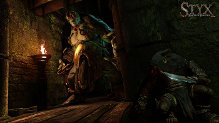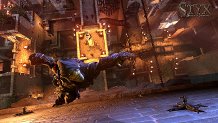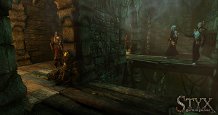Liverpool Sound and Vision Rating 8.5 out of 10
Styx: Master of Shadows is a third-person stealth based action adventure game available for download from the PlayStation Store for the PS4. The game is a spin-off of the RPG game Of Orcs and Men which was released in 2012 having also been developed by Cyanide Studio as well as another fantasy inspired game in the form of Blood Bowl which pits a variety of species from humans to orcs, elves, dwarves and more in a no-holds barred game of American Football in huge stadiums.
The story of Styx: Master of Shadows is about a World Tree that holds unimaginable power in the golden sap called amber that resonates in the heart of the tree located in the Tower of Akenash where it is jealously guarded by humans and elves. Styx is a goblin thief and assassin that would do anything to get his hands on the mysterious treasure, although firstly he must navigate his way through the humans and elves as well as discovering the secret plans to the tower that he believes will guide him to the key entrusted to open the heart of the tree.
Styx is weaker in comparison to his enemies, so despite him being an assassin; it is always best to avoid combat as much as possible as it will often lead to Styx dying as he will most likely be overpowered by all of the human and orc enemies. This is brought about by a combat system in which players must first parry the attack of an enemy in order to gain the advantage to counter the enemy attack with their own, but it will often not be timed correctly and certainly makes the game far more challenging; therefore players need to do what Styx does best and remain hidden in the shadows until the right moment to not necessarily attack an enemy, but to sneak past them instead, while living to fight another day.
As the player is the assassin they have to be careful with their movements by being as stealthy as possible as there are intricate touches as moving slowly, crouching or walking on carpets to make less noise as well as sticking to the shadows by extinguishing any torches to reduce the amount of light in the room, crawling through vents and taking cover behind walls and objects such as barrels to remain unseen, therefore enabling Styx to sneak past enemies and also without having to kill anyone in order to gain ground on his objectives. There are other simple abilities that helps Styx remain unseen such as looking through the key hole of a door before lock picking and opening it to see if there are any enemies on the other side of the door, while the bodies of enemies killed have to be hidden out of sight by dragging them into cupboards or chests to not risk alerting an enemy of your presence.
There is a skills tree that provides you with the opportunity of upgrading skills by learning them while located at your hideout and you will have plenty to learn as there are seven categories of skills with each category consisting of four skills totalling to 28 skills to learn. The seven categories include: stealth, agility, cloning, amber vision, equipment, kill and predator which are fuelled by amber from the World Tree, such as vomiting up some of the amber after having drunk it to create a clone of Styx to gain access to previously inaccessible areas and narrow openings as well as distracting enemies; using amber vision to highlight the locations of grip handles and ledges to jump up to or drop down from; becoming a better duellist by requiring less accuracy to successfully parry an enemy attack and counter it; and many more skills besides.
The character design is pretty good as it possesses a variety of character models as the lead character Styx being a goblin, while he has small number of human allies; he also has plenty of enemies in the form of human guards who come in many shapes and sizes that the player will encounter throughout the game.
The environment design is rich with gothic landscapes comprising of wooden beams and cobblestone flooring, while the World Tree is an impressive sight to behold which is rather appropriate as it is at the centre of the game, although the environments are quite expansive and scales vertically across multiple stories involving Styx having to climb to reach new heights and lower himself to the ground, alongside plenty of collectable treasure scattered throughout the environments which pleasantly encourages exploration.
The humour of the game is even showcased from the very outset with the trailers promoting the comedicly titled games Assassin’s Green and Die Harder while there are other sources of humour within such as some of the ways the enemies react when they find Styx alongside some of Styx’s dialogue.
Styx: Master of Shadows supports the share feature that allows players to upload a video clip or screen shot to Facebook or Twitter; and broadcast live gameplay footage via Twitch or Ustream as the player is experiencing the game with a simple tap of the share button and selecting the option of choice. The PS4’s hard-drive continuously stores the most recent fifteen minutes of gameplay footage, so they still have the chance to decide if the player would like to share something amazing a few minutes after it has taken place. The share feature is a next-gen revolution that has only improved with the further customisation provided by the Share Factory app that allows commentary, music, themes, stickers, effects, text, picture-in-picture video between game footage and player’s reaction from the PlayStation Camera and much more besides, which will only continue to prosper and flourish as it matures with additional features and further experimentation in the future. The Share Play feature provides a platform for a gamer that does not own the game to take control of the game you have started and invited that person to play, although it only lasts for one hour; it is a great service as it effectively presents a one hour demo of the game to anyone who invited who does not own it, while being an excellent sociable feature too.
Styx: Master of Shadows supports the remote play feature that allows play on almost any PS4 game on the PlayStation Vita via a Wi-Fi internet connection by pairing up the PS4 and Vita via configuring the settings on the PS4 to enable the Vita to connect to it, then entering the code provided from the settings menu on the Vita’s PS4 Link application with the initial setup taking around only two minutes. The performance during remote play is just as good as the PS4 version as the graphics, audio and general performance are all of an equal quality, while the majority of t he control scheme remains identical to that of the DualShock 4; there are some necessary optimisations to fit the control scheme onto the Vita as rolling by pressing R1 has now been mapped to the top right of the touch screen as has pressing L1 to use an item which has been mapped to the bottom right of the touch screen, while the touch pad has been moved to the bottom left of the touch screen to display the map, main objectives, skills and relics.
he control scheme remains identical to that of the DualShock 4; there are some necessary optimisations to fit the control scheme onto the Vita as rolling by pressing R1 has now been mapped to the top right of the touch screen as has pressing L1 to use an item which has been mapped to the bottom right of the touch screen, while the touch pad has been moved to the bottom left of the touch screen to display the map, main objectives, skills and relics.
The controls are well mapped to the DualShock 4 controller with the control scheme consisting of pressing X to jump; pressing O to crouch or drop from a ledge; pressing triangle to interact such as extinguishing a torch; pressing square to parry an enemies attack or to kill an enemy; pressing L1 to use an item such as drinking a vial of life or amber, throwing knives or sand; holding L2 and pressing X, O, square or triangle to activate the appropriate amber skill; pressing left or right on the d-pad to change an item; pressing R1 to roll; holding R2 to take cover along walls and objects; holding down on the d-pad to make a noise; changing the direction of the left analogue stick to move; changing the direction of the right analogue stick to pan the camera; pressing the share button takes the player to the share feature menu; and pressing the options button to display the pause menu, while the alternative control scheme switches crouched from O to R1 with roll moving to O. The touch pad implementation displays a map of the surroundings as well as the main objectives, skills and relics, while the light bar produces light blue when in darkness and cannot be seen, although the colour changes to white when the player is surrounded by light. There is no vibration from the DualShock 4 controller which is surprising given that it could have vibrated when an enemy has spotted Styx with a lighter vibration for a possible sighting and a heavier vibration for a confirmed sighting.
Barring some graphical glitches around the edges of the environment tending to occur when panning the camera quickly; the graphics generally are impressive with some excellent lighting and shadow effects which is important for the dynamics of a stealth game, while the characters and gothic environments also sustain a high quality of visuals.
The presentation of the game is solid with a great user interface across various menus such as the main, options and gameplay menus with support for navigation via the left analogue stick, directional pad and face buttons, although it does not include support for navigation via the right analogue stick and touch pad. The background of the menu screens revolves around Styx crouching down and looking around his surroundings with massive structures not too far away as the moon shines as brightly as the stars in the night sky.
The audio consists of voice-overs, sound effects and music with the voice-over cast having plenty of experience across the board with Saul Jephcott and Paul Bandey having voiced characters in Beyond: Two Souls, while David Gasman has voiced characters in the aforementioned game, Heavy Rain and a number of Rayman games. Tom Morton has provided voice-overs in Bound by Flame; amongst many more experienced actors. The sound effects mostly include the emphasis of how loud the footsteps are to provide a sense of awareness in the scenario that an enemy is nearby, while there are ambient sound effects such as a howling wind and the machinery used around the World Tree, alongside climactic music. There is no DualShock 4 speaker implementation which is surprising as it could have layered the audio by producing the voice-overs, sound effects, ambient sound effects or music.
The trophy list includes 34 trophies with 20 bronze, 8 silver, 5 gold and 1 platinum trophy. There are some easier ones that can naturally be earned as progression is made through the story, such as the Passkey bronze trophy for unlocking 20 doors; the Born in the Shadow bronze trophy for extinguishing 30 torches and the Music Lover bronze trophy for looking at the World Tree a bit too long until music starts playing a couple of minutes later. However, the bulk of the trophies are harder to achieve such as the Great Power gold trophy for unlocking all skills; the My Precious gold trophy for gathering all of the treasures; as well as 8 trophies for progressing through the introduction and each of the 7 missions of the story and a lot of trophies for killing enemies which in both counts are harder than what they appear to be due to Styx’s lack of strength to actually overpower enemies in battle. It is estimated that depending upon skill and a good trophy guide to provide some helpful tips that it would take between 15 to 25 hours to platinum the trophy list.
There are four difficulty levels including easy, normal, hard and goblin with the major differences being enemies are able to make detection faster, while in melee attack they are able to kill the character in one hit and their projectiles will inflict significant damage during the goblin difficulty, although easy difficulty will see enemies taking longer to detect you and the damage they inflict being substantially reduced, which is a great design choice as the easy difficulty provides an experience suitable for a casual player or someone that just wants to be guaranteed to see the end of the game, while the goblin difficulty is for a more mature hardcore gamer that is capable of coping with the extremes imposed with the difficulty curve.
There are no online leaderboards upon the release of the game, although the possibility of introducing online leaderboards via a patch has been discussed to display the fastest time for players to complete each mission, although only time will tell if this makes it from the Steam release to the PS4 port.
There is no local or online multiplayer, although there perhaps could have been competitive split-screen multiplayer and online multiplayer something along the lines of a mode in which all of the players are attempting to collect the most treasure that is randomly positioned throughout the chosen environment, while another mode could have been more based on each of the players fighting each other in an attempt to kill the most enemies, therefore levelling up to become more powerful and harder to kill.
The replayability stems from the eight large scale missions including the introduction with collectable treasure providing a reason to fully explore the environments, four difficulty levels to increase the challenging A.I. even further and a skills tree of 28 upgradeable skills, while online leaderboards may be patched in which would substantially increase the amount of replay value beyond the extensive replayability already contained within the game.
Overall, Styx: Master of Shadows is a game with ambition to take stealth games in a bold new direction were combat proficiency is not a guarantee but stealth is a requirement, while applying some humour to the story via the dialogue. It should appeal to players who like stealth games, but want to see something new in them rather than endlessly covering the same ground until the well has run dry.
Jason Bonnar
Analysis
- Title: Styx: Master of Shadows
- Developer: Cyanide Studio
- Publisher: Focus Home Interactive
- System: PS4
- Format: PSN Download
- Cross-Buy: No
- Cross-Play: No
- Players: 1
- Hard Drive Space Required: 5.52GB

